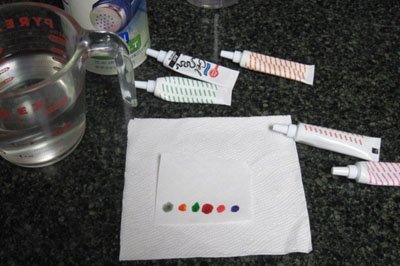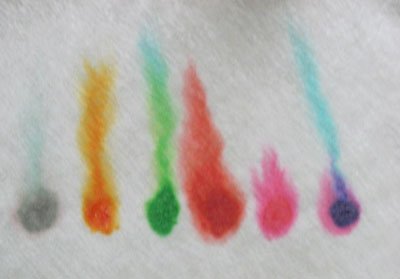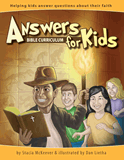Chromatography Experiment
Have you ever heard of chromatography? This long word is made up of two smaller words—chromato- which is color and -graphy which is to write or represent. Through the use of chromatography, we can study interesting color combinations! Chromatography can be used to separate color mixtures into the individual dyes used to make the colors. This fun and easy experiment will help you to understand chromatography first-hand. You will need an adult helper.
Materials
- Food color gels in several colors (fine tipped tubes work the best)
- Glass measuring cup
- Water
- 1/8 teaspoon salt
- Coffee filters (You should have several in case you make a mistake or want to experiment further)
- Paper plate or napkins

Food color has been dabbed on a rectangular piece of coffee filter. The next step will be to place the bottom edge of the filter on the surface of the salt water in the measuring cup.
Procedure
- Cut coffee filter into rectangles that measure approximately 3 inches by 2 1/2 inches. This does not have to be exact.
- Place coffee filter rectangle on a paper plate or several napkins, so you do not stain your work surface with food color.
- Starting with the first food color gel you have chosen, dab a small circle of food color (gently pressing food color tube to filter) about 1/4 inch from the bottom left side of the rectangle.
- Repeat with different colors, spacing them about 1/4 inch apart in a row. If you don't have enough room for all the colors you want to test, cut additional coffee filter rectangles and use them also.
- Fill glass measuring cup with 1 1/2 cups of warm water.
- Add 1/8 teaspoon salt to the water and stir until dissolved.
- Holding the coffee filter with the row of food color dots running along the bottom, carefully place the bottom edge of the filter to the surface of the water in the measuring cup. You do not want the water to touch the row of food color dots. The water should only touch the bottom length of the filter. Watch as the water absorbs up into the filter, drawing colors up with it. After the water reaches the top of the filter, hang the filter to dry. Repeat with additional filters if you'd like.

Results from the chromatography experiment. Notice how different dyes have separated out from the color mixtures. For instance, the purple food color (far right) contains pink and blue dyes in it.
Did you notice that the salt water pulled different colors up the filter above some of the food color dots? Some colors are made up of several dyes that have been mixed together. Some dyes are separated out when the salt water is absorbed into the filter. For instance, the black food color that we used had a streak of blue above it. The purple food color had bright pink around it with a large streak of blue above it. Your results may vary. You can read the ingredients list on the side of your food color box to see some of the dyes that were used to make the colors. Do you see them on your filter? Are you surprised by some of the results? Why do you think some colors traveled farther than others? You have just used chromatography to separate dyes that were mixed together to make food colors! For “extra credit,” try using different solvents (other than salt water).
To look at more fun experiments, please see Science.
Recommended Resources
- © 2024 Answers in Genesis
- Privacy Policy
- Contact
- About



